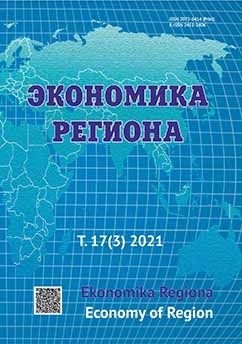Пространственный анализ трансформации бюджетной самостоятельности и безопасности региональных систем
Transformation of Regional Budgetary Independence and Security: Spatial Analysis
Author(s): Ilya Viktorovich Naumov, Natalia Leonidovna NikulinaSubject(s): Social Sciences, Economy, Geography, Regional studies, National Economy, Financial Markets, Public Finances, Fiscal Politics / Budgeting
Published by: Институт экономики Уральского отделения Российской академии наук
Keywords: regional budgetary independence; regional budgetary security; public debt; spatial heterogeneity; spatial autocorrelation; Moran’s I; investments; debt securities; budget deficit; budget surplus;
Summary/Abstract: The issue of increasing budgetary independence and security is relevant for the majority of territorial systems, both at the regional and municipal levels. It was hypothesised that changes in the structure of regional public debt have a negative impact on their budgetary security. According to this hypothesis, an increase in the proportion of bank borrowing and corresponding decrease in the issue of debt securities by the constituent entities of the Russian Federation leads to a greater overall debt burden on the regional budget. In order to study transformation processes affecting budgetary independence and regional security. We developed a methodology to permit a separate assessment of these concepts. According to this approach, we propose to evaluate the budgetary independence of regional systems in terms of: (1) the balance of the budget (ratio of internal tax and non-tax revenues to budget expenditures); (2) financial dependence on transfers and subsidies from budgets at other levels; (3) budget security, taking into account gratuitous and non-gratuitous transfers. Thus, budget ary security can be assessed in accordance with the public debt dynamics, as well as the level of budgetary debt covered by the region’s own tax and non-tax revenues. The novelty of the presented methodological approach consists in its systematic use of Moran’s I for various spatial weight matrices combined with regression analysis methods based on panel data. Testing this methodology demonstrated the spatial heterogeneity of regional fiscal capacity, highlighting the financial dependence of most regions on federal and other gratuitous transfers. Autocorrelation analysis carried out according to Moran’s I using various spatial weight matrices confirmed the increasing tendency of the budgetary debt of Russian regions towards spatial heterogeneity. Future studies will focus on simulating the influence of various factors on regional budgetary security in order to predict the dynamics of its change.
Journal: Экономика региона
- Issue Year: 17/2021
- Issue No: 3
- Page Range: 1042-1056
- Page Count: 15
- Language: Russian

